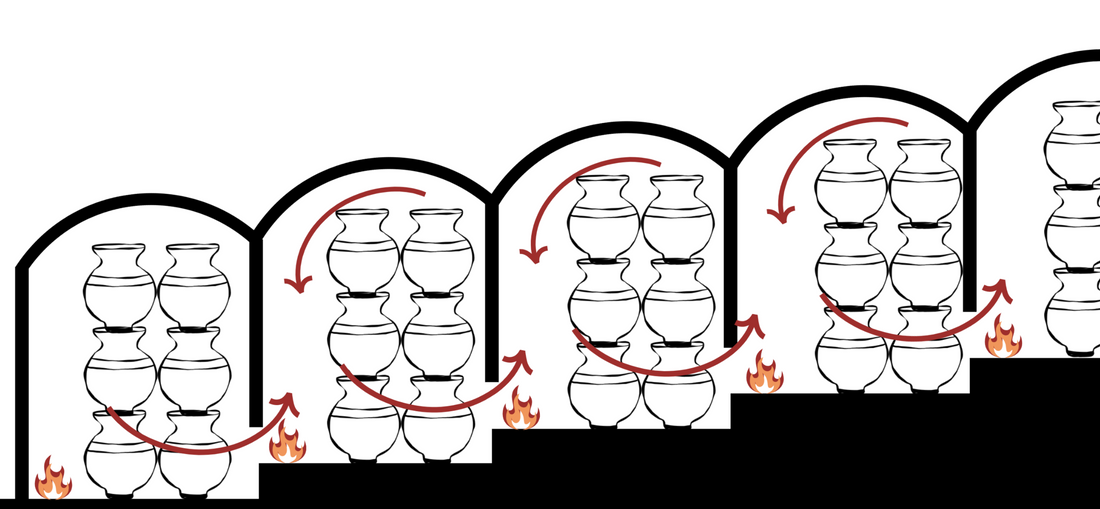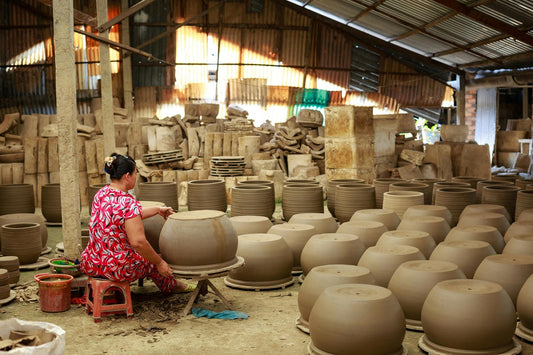
Why Are Handmade Pots Different Colors?
Share
Why Are Handmade Pots Different Colors?
Table of Contents
Why Some Colors Are Harder to Achieve
Handmade Vietnamese pottery is admired worldwide for its unique finishes and natural color variations. But have you ever wondered why no two pots look exactly the same, even if they’re glazed in the same color? The answer lies in the centuries-old firing process, where heat, flame, and glaze chemistry interact in ways that make every handmade pot one-of-a-kind.
In this article, we’ll explore how kiln temperature, chamber placement, rows, and glaze reactions shape the colors of handcrafted ceramic pots.
The Role of Kiln Temperature
What causes Vietnamese pottery to have unique imperfections? Unlike tunnel gas kilns used for mass-produced ceramics, traditional Vietnamese Dragon kilns use wood-firing, creating temperature variations that affect glaze color, leaving no two pots alike.
- Chamber heating: Each dragon kiln chamber has a flame inside to fire the pottery, engulfing the entire chamber in a high heat, while getting the next chamber warm and ready for firing as well. As this occurs, factories place greenware atop each chamber to assist in the drying process.
- Location inside the kiln: While inside the kiln, pots are stacked in two rows, one closer to the flame and one behind. Although the whole chamber receives enough heat to thoroughly fire each pot, the row that's closer to the fire will receive more overall heat, altering each pot's final finish.
- Pot direction: Since pots don't rotate while inside the kilns, each pot will have a side facing the fire and facing away, regardless of location inside the kiln. This can cause one side of a pot to differ slightly.
This uneven heat is not a flaw, it’s what makes handmade pottery special. It’s why you’ll see different shades of the “same” glaze across a collection of handmade pots.

Glaze and Flame Interactions
Glaze chemistry plays a major role in pottery color. When flames and ash touch the surface of glazed pottery, they create subtle variations—specks, streaks, and color shifts that no factory-made piece can replicate. Wood ash that becomes part of the speckles and color variations in the glaze mean that different colors have unique reactions to the kiln.
- Red: Requires precise, high temperatures. Too cool and it turns orange; too hot and it burns brown.
- Yellow & Purple: Also sensitive and hard to fire consistently.
- White: Easily “stained” by ash or neighboring glazes.
-
Blue, Black, and Brown: More stable, firing consistently across temperature ranges.
This delicate balance of chemistry and heat is why collectors value authentic Vietnamese handmade pots, each pot carries a story of a centuries-old tradition
Why Some Colors Are Harder to Achieve
Not all glaze colors are equal. Some are considered “premium” because of the difficulty in firing them correctly.
- Hard to Fire Consistently: Red, orange, yellow, and purple. These require exact heat ranges and controlled placement.
-
Easy to Fire Consistently: Blue, black, and brown. These glazes are more forgiving to temperature swings inside the kiln.
For some customers, firing a perfect copper red or deep purple pot is both a challenge and a triumph. For manufacturers, the demanding nature of the glaze makes it difficult to keep consistent, hence its usual higher price.
Final Thoughts
Handmade Vietnamese pots are different colors not just because of glaze recipes, but because of where they sit in the kiln, how heat flows through chambers, and how flames dance across their surfaces. The result is pottery with character, depth, and natural beauty—pieces that tell the story of fire and earth.
For garden centers and nurseries, this means every pot you carry or display is unique and authentic. And for those who love pottery, it’s a reminder that true craftsmanship cannot be mass-produced.
Want to learn more about wood-fired Vietnamese pottery? Contact John@ttpottery.com for product catalogs, pricing, production lead times, or any other inquiries!


